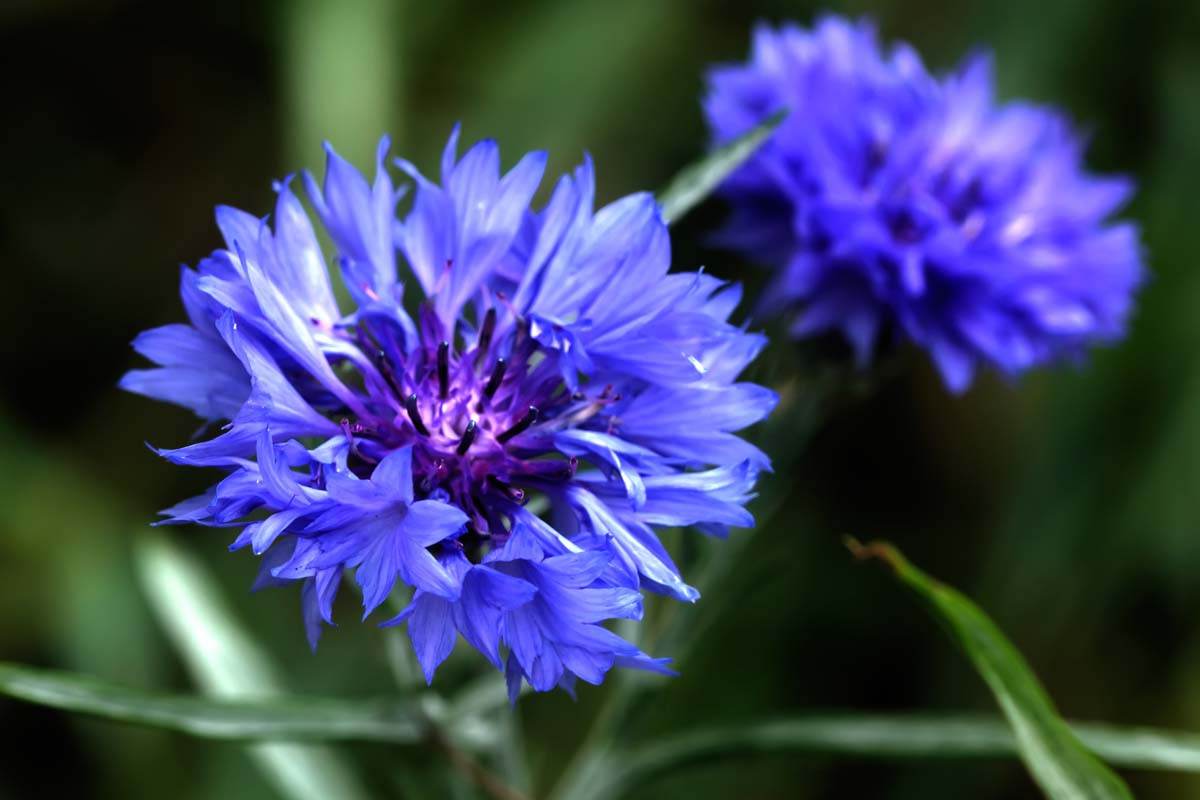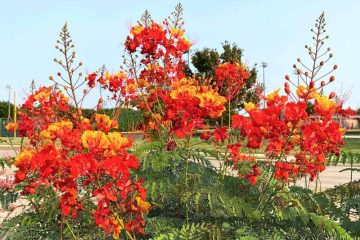Bachelor Buttons, also known as Cornflowers (Centaurea cyanus), are charming annuals celebrated for their vibrant blue blooms, though they also come in pink, white, and purple. These hardy flowers, native to Europe, thrive in a variety of soil conditions and are particularly popular in cottage gardens and wildflower meadows. Bachelor Buttons are easy to grow, requiring minimal care, making them ideal for both novice and experienced gardeners. They not only enhance garden aesthetics but also attract beneficial pollinators like bees and butterflies. Additionally, their cut flowers are perfect for bouquets, adding a rustic touch to floral arrangements.
| Common Name | Cornflower, bachelor’s button |
| Botanical Name | Centaurea cyanus |
| Family | Asteraceae |
| Plant Type | Annual |
| Mature Size | 12–48 in. tall, 10–12 in. wide |
| Sun Exposure | Full, partial |
| Soil Type | Moist, well-drained |
| Soil pH | Alkaline |
| Bloom Time | Spring, summer |
| Flower Color | Blue, purple, pink, white, red |
| Hardiness Zones | 2–11 (USDA) |
| Native Area | Europe |
How to Grow Bachelor Buttons?
The following are the methods to grow Bachelor Buttons (Cornflower):
Selecting the Right Location
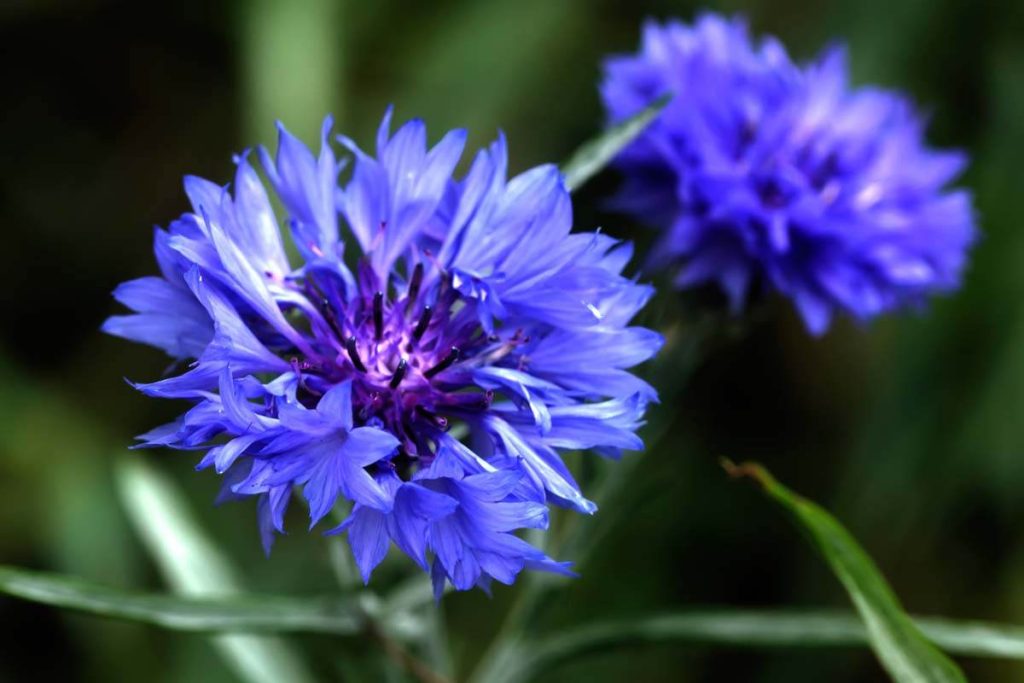
Bachelor Buttons thrive in full sun like China Doll Plants, so choose a spot in your garden that receives at least 6-8 hours of direct sunlight each day. They prefer well-drained soil, although they can tolerate various soil types, including poor soils. Ensure the location is not prone to waterlogging, as these plants do not thrive in overly wet conditions. When selecting a site, consider the mature height of Bachelor Buttons, which typically ranges from 12 to 36 inches, and plan accordingly to avoid overshadowing smaller plants nearby.
Preparing the Soil
Prepare the soil by removing weeds and breaking up large clumps. Bachelor Buttons prefer neutral to slightly alkaline soil, with a pH range of 6.6 to 7.5. Improve soil fertility by incorporating organic matter, such as compost or well-rotted manure, into the top few inches. While they are not heavy feeders, adding a balanced, slow-release fertilizer can promote healthy growth and prolific blooming. Ensure good drainage by avoiding compacted soils and considering raised beds if necessary. Rake the soil smooth to create an even surface for planting.
Planting Seeds
Sow Bachelor Button seeds directly in the garden in early spring, as soon as the soil can be worked. Scatter seeds thinly over the prepared soil, then cover lightly with a ¼ inch layer of soil. Maintain soil moisture to aid germination, which typically occurs within 7-10 days. For continuous blooms, consider succession planting every 2-3 weeks until midsummer. Thin seedlings to 6-12 inches apart once they are 2-3 inches tall to reduce competition and encourage vigorous growth. Bachelor Buttons can also be started indoors 4-6 weeks before the last frost and transplanted outdoors.
Watering Requirements
Bachelor Buttons require moderate watering, especially during their initial growth phase. Water the plants deeply once a week, providing about 1 inch of water. Allow the soil to dry out between waterings to prevent root rot. Once established, these drought-tolerant flowers need less frequent watering. In periods of prolonged drought, increase watering to keep the soil slightly moist. Avoid overhead watering to reduce the risk of fungal diseases. Mulching around the plants can help retain soil moisture and reduce the frequency of watering.
Fertilization Needs
While Bachelor Buttons are not heavy feeders, a light application of balanced, all-purpose fertilizer can boost their growth and flowering. Apply a granular or liquid fertilizer once in the spring when the plants are about 6 inches tall and again during the blooming period. Follow the manufacturer’s instructions to avoid over-fertilization, which can lead to excessive foliage growth at the expense of flowers. Organic options like compost tea or fish emulsion can also provide nutrients without the risk of chemical buildup in the soil.
Deadheading and Pruning
Deadheading spent flowers regularly encourages continuous blooming throughout the growing season. Snip off faded blooms just above a set of healthy leaves using clean, sharp scissors or pruners. This practice prevents the plants from going to seed too early and promotes the development of new buds. For a tidier appearance and to stimulate bushier growth, prune leggy stems by cutting back to a healthy leaf node. Regular maintenance helps maintain a neat and attractive garden display, ensuring Bachelor Buttons remain vibrant and productive like Dipladenia.
How to Care Bachelor Buttons?
Watering Bachelor Buttons
Water Bachelor Buttons regularly, especially during dry periods, to ensure consistent soil moisture. These plants prefer moderate watering and should receive about 1 inch of water per week. Water deeply and infrequently rather than shallow and often, allowing the soil to dry out slightly between waterings. This encourages deep root growth and helps prevent diseases caused by overly moist soil. Avoid overhead watering to minimize the risk of fungal infections. Using drip irrigation or soaker hoses can be effective in delivering water directly to the roots.
Fertilizing Bachelor Buttons
Although Bachelor Buttons are not heavy feeders, providing them with a light, balanced fertilizer can enhance their growth and blooming. Apply a granular, slow-release fertilizer in early spring when new growth begins, following the package instructions for the correct amount. Alternatively, use a liquid fertilizer every 4-6 weeks during the growing season. Organic fertilizers, such as compost tea or fish emulsion, are also excellent options to boost soil fertility without the risk of chemical buildup. Avoid over-fertilizing, as this can lead to excessive foliage growth at the expense of flowers.
Pruning and Deadheading
Regular pruning and deadheading are essential for maintaining the health and appearance of Bachelor Buttons. Remove spent blooms promptly to encourage continuous flowering throughout the season. Use clean, sharp scissors or pruners to snip off faded flowers just above a healthy set of leaves. Prune leggy or overgrown stems to promote bushier growth and improve air circulation. Cut back the plants by about one-third in mid-summer if they become too sprawling. This practice revitalizes the plants, stimulates new growth, and extends the blooming period.
Supporting Bachelor Buttons
Bachelor Buttons can grow tall and may require support to prevent them from flopping over, especially in windy conditions. Use stakes or small cages to keep the plants upright. Insert the stakes into the ground next to the plants early in the season before they become too large. Tie the stems loosely to the stakes with garden twine or soft plant ties, allowing room for growth. Regularly check and adjust the ties as needed to avoid damaging the stems. Providing support helps maintain an attractive, orderly garden and ensures the plants remain healthy and productive.
Mulching Bachelor Buttons
Mulching around Bachelor Buttons helps retain soil moisture, suppress weeds, and regulate soil temperature. Apply a 2-3 inch layer of organic mulch, such as straw, shredded bark, or compost, around the base of the plants. Keep the mulch a few inches away from the stems to prevent rot and pest infestations. Mulch also improves soil structure and fertility as it breaks down over time. Replenish the mulch layer as needed throughout the growing season to maintain its effectiveness and continue providing these benefits to the plants.
Winter Care
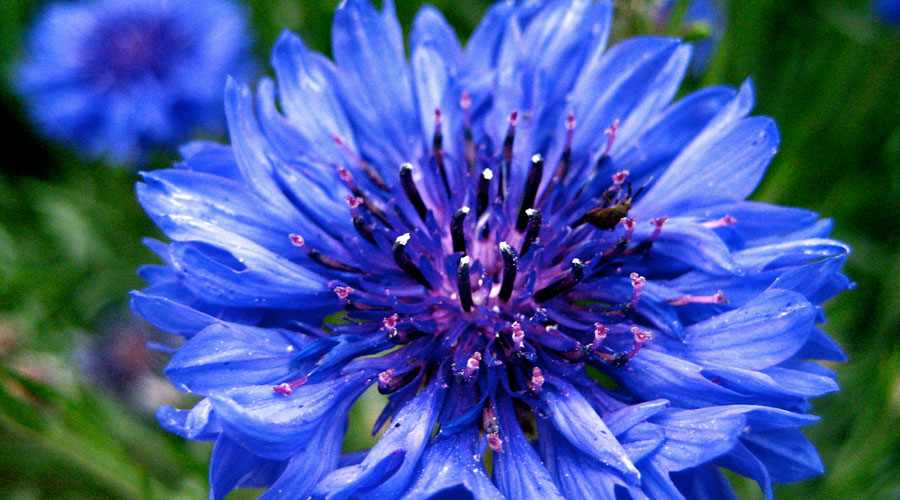
In regions with mild winters, Bachelor Buttons may survive as perennials. Mulch around the base of the plants in late fall to protect the roots from freezing temperatures. Use straw, leaves, or other organic materials to insulate the plants. In colder climates, treat Bachelor Buttons as annuals and collect seeds for replanting next year. Alternatively, start new plants indoors in late winter and transplant them outdoors after the last frost. Proper winter care ensures your garden remains vibrant and filled with Bachelor Buttons year after year, providing a reliable source of color and charm.
Companion Planting
Bachelor Buttons make excellent companion plants due to their ability to attract beneficial insects and pollinators. Plant them alongside vegetables, herbs, or other flowering plants to enhance biodiversity and improve garden health. They pair well with plants like tomatoes, lettuce, and roses. Their bright blue flowers add visual interest and help draw pollinators, such as bees and butterflies, which can increase the productivity of nearby crops. Incorporating Bachelor Buttons into your garden design promotes a healthy ecosystem and supports the overall success of your garden.
How To Propagate Bachelor Buttons?
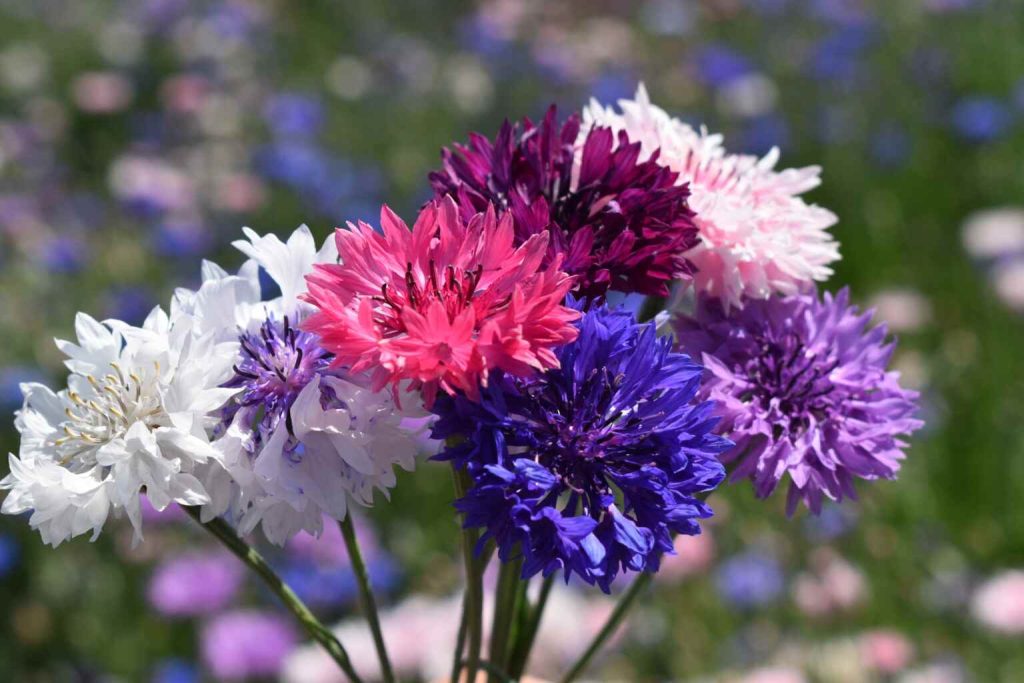
Propagating Bachelor Buttons (Centaurea cyanus) is relatively simple and can be done through seeds. Here’s a step-by-step guide on how to propagate these beautiful flowers:
Propagation from Seeds
- Collecting Seeds:
- Wait until the flower heads dry on the plant.
- Cut the flower heads and place them in a paper bag to allow them to fully dry.
- Shake the bag to release the seeds from the dried flower heads.
- Preparing the Soil:
- Choose a sunny location with well-draining soil.
- Bachelor Buttons prefer slightly alkaline to neutral pH soil.
- Work compost or organic matter into the soil to improve fertility and drainage.
- Sowing Seeds Outdoors:
- Direct sow the seeds in the garden in early spring, as soon as the soil can be worked.
- Scatter the seeds thinly over the prepared soil.
- Lightly rake the soil to cover the seeds with a thin layer of soil (about 1/4 inch deep).
- Water the area gently to moisten the soil.
- Sowing Seeds Indoors:
- Start seeds indoors 4-6 weeks before the last expected frost date.
- Fill seed trays or pots with a good-quality seed starting mix.
- Sow the seeds on the surface of the soil and lightly press them in.
- Cover the seeds with a thin layer of soil (about 1/4 inch deep).
- Water gently to moisten the soil.
- Place the trays or pots in a warm, sunny location or under grow lights.
- Transplanting Seedlings:
- Once seedlings have developed 2-3 true leaves and the danger of frost has passed, they can be transplanted outdoors.
- Harden off the seedlings by gradually exposing them to outdoor conditions over a week.
- Plant the seedlings in the garden, spacing them about 8-12 inches apart.
- Water the newly transplanted seedlings well.
Tips for Successful Propagation
- Watering: Keep the soil consistently moist but not waterlogged during the germination period.
- Thinning: If seeds are sown too thickly, thin the seedlings to avoid overcrowding.
- Mulching: Apply a thin layer of mulch around the plants to retain moisture and suppress weeds.
- Deadheading: Regularly remove spent flowers to encourage continuous blooming and prevent self-seeding if you do not want them to spread excessively.
By following these steps, you can successfully propagate Bachelor Buttons and enjoy their bright, cheerful blooms in your garden.
Bachelor Buttons Benefits
1. Aesthetic Appeal
Bachelor Buttons, also known as cornflowers, add vibrant blue hues to gardens, creating a visually appealing landscape. Their bright colors can enhance the overall look of flower beds and meadows.
2. Attracting Pollinators
These flowers are excellent at attracting beneficial pollinators like bees, butterflies, and other insects. This can improve the health and productivity of your garden by promoting pollination for other plants.
3. Easy to Grow
Bachelor Buttons are relatively easy to grow and maintain. They can thrive in a variety of soil conditions and require minimal care, making them an ideal choice for beginner gardeners.
4. Drought Tolerance
Once established, Bachelor Buttons are quite drought-tolerant. This makes them suitable for gardens in areas with limited water supply or for gardeners looking to reduce their water usage.
5. Versatile Use in Floral Arrangements
The long stems and striking blue flowers of Bachelor Buttons make them a popular choice for cut flower arrangements. They can be used fresh or dried, adding a charming touch to bouquets and decorative displays.
6. Medicinal Uses
Historically, Bachelor Buttons have been used for their medicinal properties. They have been employed in traditional remedies to treat eye ailments, fevers, and wounds due to their anti-inflammatory and soothing properties.
7. Edible Flowers
The petals of Bachelor Buttons are edible and can be used as a garnish in salads, desserts, and beverages. They add a splash of color and a mild, clove-like flavor to culinary dishes.
8. Natural Dye
The petals of Bachelor Buttons can be used to produce a natural dye. This dye has been traditionally used for coloring fabrics and other materials, offering an eco-friendly alternative to synthetic dyes.
9. Wildlife Habitat
In addition to attracting pollinators, Bachelor Buttons provide habitat and food for various beneficial insects and birds. This can help promote biodiversity in your garden or landscape.
10. Symbolic Meanings
Bachelor Buttons have symbolic meanings in different cultures. They are often associated with love and fidelity, making them a thoughtful addition to romantic bouquets and gardens.
By incorporating Bachelor Buttons into your garden, you can enjoy these benefits while contributing to a healthier and more vibrant ecosystem.
Common pests and diseases of Bachelor Buttons
Bachelor Buttons, also known as Cornflowers (Centaurea cyanus), are relatively hardy plants but can still fall victim to a variety of pests and diseases. Here are some common issues and how to manage them:
Common Pests
- Aphids
- Description: Small, soft-bodied insects that suck sap from plants.
- Symptoms: Distorted growth, sticky residue (honeydew), and sooty mold.
- Management: Spray with water to dislodge, use insecticidal soap, or introduce beneficial insects like ladybugs.
- Spider Mites
- Description: Tiny, spider-like pests that feed on plant sap.
- Symptoms: Fine webbing on plants, yellowing or stippling of leaves.
- Management: Increase humidity around plants, spray with water, use miticides if infestation is severe.
- Thrips
- Description: Tiny, slender insects that feed on plant cells.
- Symptoms: Silvering or stippling on leaves, distorted flowers.
- Management: Use blue sticky traps, insecticidal soap, or neem oil.
- Cutworms
- Description: Caterpillars that cut down seedlings at soil level.
- Symptoms: Seedlings or young plants cut off at the base.
- Management: Use collars around seedlings, handpick at night, or apply biological controls like Bacillus thuringiensis (Bt).
Common Diseases
- Powdery Mildew
- Description: Fungal disease causing white, powdery growth on leaves.
- Symptoms: White, powdery spots on leaves, stems, and flowers.
- Management: Ensure good air circulation, avoid overhead watering, use fungicides if needed.
- Rust
- Description: Fungal disease that causes rust-colored pustules on leaves.
- Symptoms: Orange or brown spots on leaves and stems.
- Management: Remove and destroy affected leaves, use fungicides, ensure good air circulation.
- Leaf Spot
- Description: Fungal or bacterial disease causing spots on leaves.
- Symptoms: Brown or black spots on leaves, sometimes with yellow halos.
- Management: Remove and destroy affected leaves, avoid overhead watering, use appropriate fungicides or bactericides.
- Root Rot
- Description: Disease caused by overwatering or poorly drained soil leading to fungal growth.
- Symptoms: Wilting, yellowing leaves, and rotting roots.
- Management: Ensure well-draining soil, avoid overwatering, remove affected plants and treat soil if necessary.
Preventative Measures
- Cultural Practices: Proper spacing for good air circulation, regular monitoring of plants, and removing debris and diseased plant material.
- Watering: Water at the base of the plant to keep foliage dry and avoid overwatering.
- Healthy Soil: Maintain healthy soil with good drainage and adequate nutrients.
- Resistant Varieties: Choose disease-resistant varieties when available.
By following these guidelines, you can help protect your Bachelor Buttons from common pests and diseases, ensuring healthy and vibrant plants.

